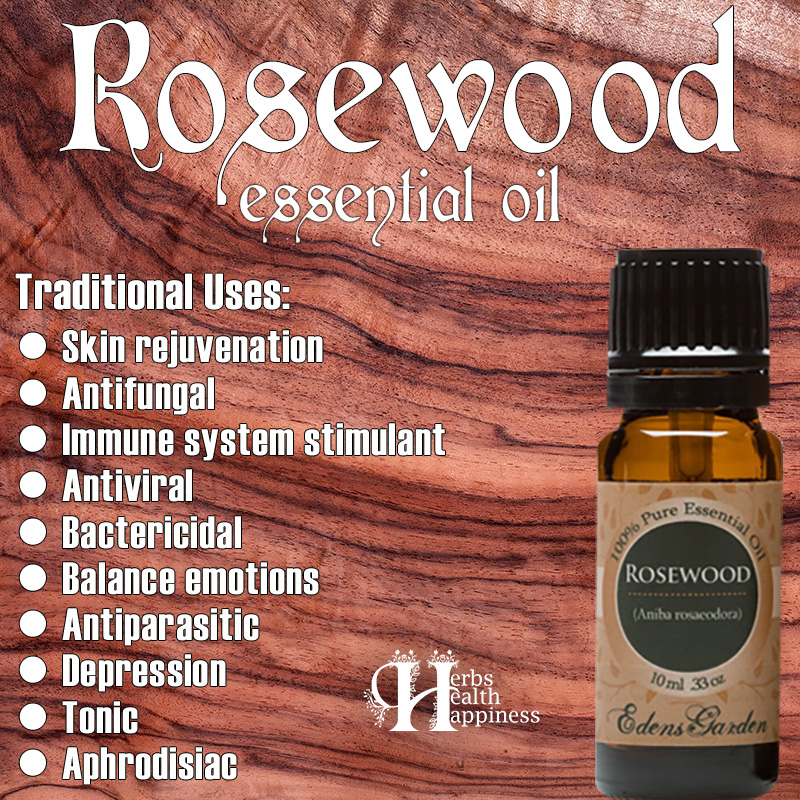
Rosewood Essential Oil – Uses And Benefits – image to repin / share
Background pic – Wikipedia – lic. under CC 3.0
Essential oil pic – amazon.com (click here to buy)
Rosewood Essential Oil – General Description
Rosewood essential oil is extracted from the wood chippings of Aniba rosaeodora, commonly known as Brazilian rosewood, a large fragrant evergreen tree native to the tropical rainforests of South America along the northwestern Amazon basin. [1] After the tree is cut down, the trunk is customarily allowed to float toward a distillery where the comminuted trunk wood is steamed to yield the coveted essential oil. [2] However, because of the high level of exploitation of Brazilian rosewood over the years and indiscriminate cutting of trees, regardless of size and maturity, the Aniba rosaeodora population has declined markedly over several areas where the species used to flourish and harvesting has become seriously expensive, Brazil being the sole producer at present to the world market. [3] Aniba rosaeodora is now listed on the IUCN Red List of Threatened Species™, which states that most of the damage was done in the period from 1910 to 1930 and that the increasing use of synthetic oils has meant that exploitation has declined significantly.
Rosewood essential oil appears clear with a yellow tinge and thin consistency; additionally, it has a sweet, woody, fruity, floral aroma that is medium as regards strength. It blends excellently with lavender, orange, lemon, tangerine, sandalwood, cedarwood, and geranium essential oils. [4] Rosewood essential oil is heavily utilized by the perfumery industry as a fragrance, mostly in soaps, and as a vital source of natural linalool.
Rosewood Essential Oil – Uses and Reported Benefits
Rosewood essential oil has been claimed by many to have superior cell stimulant and tissue-regenerating properties, which is a remarkable feat for skin rejuvenation. Its health benefits come from a wide range of properties it is reported to possess, including bactericidal, antifungal, antiviral, antiparasitic, immune system stimulant, tonic, and aphrodisiac effects. It also has a calming and relaxing action and is favored among aromatherapists for its spicy, floral aroma that drives depression away and balances emotions. [4]
Rosewood Essential Oil – Contraindications and Safety
Like other essential oils, rosewood EO should not be taken internally. Rosewood essential oil is very much suggested to be used highly diluted with a carrier oil, and since this essential oil is considered a “hot oil,” it should not be used in bath water. Moreover, caution should be exercised upon using this essential oil without advice from a qualified practitioner, especially if one is pregnant or nursing. Rosewood essential oil may cause photosensitization and should be applied on skin only in diluted concentration. [5]
Rosewood Essential Oil – Scientific Studies And Research
Rosewood Essential Oil as cytotoxic agent: Sœur et al. (2011) investigated the favorable effects of rosewood essential on human skin cells and reported its promising anticancer activity as an inducer of apoptosis (i.e., programmed cell death) in precancerous and cancerous skin cells. In their study, rosewood essential oil was tested on four skin lines, namely, human epidermoid carcinoma cell line A431, immortal HaCaT cells (which correspond to the early stage of skin cancer development), transformed normal HEK001 keratinocytes, and primary normal NHEK keratinocytes. Results revealed that rosewood essential oil selectively killed the A431 and HaCaT cells but exerted minimal cytotoxic effect on HEK001 and NHEK keratinocytes. In the A431 and HaCaT cells, rosewood essential oil induced the production of reactive oxygen species and depolarization of the mitochondrial membrane, leading to caspase-dependent cancer cell death. [6]
Rosewood Essential Oil as antifungal: A 2004 study from the University of Belgrade, Serbia, provided evidence of rosewood essential oil’s fungistatic and fungicidal activities against 17 micromycetes, all of which are either food poisoning fungi, spoilage-causing fungi, or plant and animal pathogens. [7] Furthermore, a group of Italian researchers from the University of Bari had administered rosewood essential oil with gentamicin, an antibiotic. Using Mueller-Hinton broth microdilution method as a form of evaluation, they had observed a synergistic interaction between rosewood essential oil and gentamicin against fifteen different strains of Gram-positive and Gram-negative bacteria, contributing to the evidence on the in vitro bacterial growth-deterring property of the essential oil. [8] Hammer, Carson, and Riley (1999) compared the antimicrobial activity of various plant oils and extracts against several pathogenic species such as Acinetobacter baumanii, Aeromonas veronii biogroup sobria, Candida albicans, Enterococcus faecalis, Escherichia coli, Klebsiella pneumoniae, Pseudomonas aeruginosa, Salmonella enterica subsp. enterica, Serratia marcescens, and Staphylococcus aureus through an agar dilution method. According to this study, rosewood inhibited all organisms except P. aeruginosa at =2·0% (v/v). [9]
Rosewood Essential Oil as sedative: De Almeida et al. (2009) investigated the sedative effect of rosewood essential oil on mouse models and the effect of the oil’s main component, linalool, on the isolated nerve using the single sucrose-gap technique. The results illustrated a significant reduction in latency and an increase in sleeping time duration upon the administration of 200 and 300 mg/kg rosewood essential oil. This Brazilian study pointed out that the sedative effect of rosewood essential oil may be attributed partly to the decline in action potential amplitude that provokes in turn a decrease in neuronal excitability. [10]
Rosewood Essential Oil – Molecular Components and Chemistry
As mentioned earlier, linalool, a terpenic alcohol well known scientifically for its anxiolytic, sedative, and anticonvulsant effects, is the chief constituent of rosewood essential oil. It is a natural plant product used in perfumes and cosmetics and as flavoring. A considerable number of studies have demonstrated the antihyperalgesic and antinociceptive effects of linalool in various animal models, both properties being associated with linalool’s stimulation of the cholinergic, opioidergic, and dopaminergic systems, with its local anesthetic activity, and with the blockade of N-methyl-D-aspartate receptors. Linalool reduces the amount of nitric oxide produced, a proinflammatory factor that plays an key role in edema formation and pain generation. [11] Linalool has been proved as well to be an effective anti-inflammatory agent capable of decreasing edema in rat models [12] and an antimicrobial and insect-repellent substance.
References:
[1] Rosewood essential oil. Wikipedia. Retrieved from https://en.wikipedia.org/wiki/Rosewood_oil
[2] Aniba rosaeodora. Forest Legality Alliance: World Resources Institute. Retrieved from https://risk.forestlegality.org/species/aniba-rosaeodora
[3] Aniba rosaeodora. The IUCN Red List of Threatened Species. Retrieved from https://iucnredlist.org/details/full/33958/0
[4] Rosewood 100% Pure Therapeutic Grade Essential Oil- 10 ml. Amazon. Retrieved from https://amazon.com/Rosewood-100-Therapeutic-Grade-Essential/dp/B002RTI7K2
[5] Rosewood (Aniba rosaeodora) Pure Essential Oil – 30 ml (1 Fl. Oz) Aromatherapy. Amazon. Retrieved from https://amazon.com/Rosewood-Aniba-rosaeodora-Pure-Essential/dp/B00CIJBRH6
[6] Sœur J. et al. (2011). Selective cytotoxicity of Aniba rosaeodora essential oil towards epidermoid cancer cells through induction of apoptosis. Mutation Research. 718(1-2): 24-32. doi: 10.1016/j.mrgentox.2010.10.009. Retrieved from https://pubmed.ncbi.nlm.nih.gov/21070863
[7] Simic A., Sokovic M. D., Ristic M., Grujic-Jovanovic S., Vukojevic J., Marin P. D. (2004). The chemical composition of some Lauraceae essential oils and their antifungal activities. Phytotherapy Research. 18(9): 713-717. Retrieved from https://pubmed.ncbi.nlm.nih.gov/15478207
[8] Rosato A. et al. (2010). In vitro synergistic antibacterial action of certain combinations of gentamicin and essential oils. Current Medicinal Chemistry. 17(28): 3289-3295. Retrieved from https://pubmed.ncbi.nlm.nih.gov/20666717
[9] Hammer K. A., Carson C. F., Riley T. V. (1999). Antimicrobial activity of essential oils and other plant extracts. Journal of Applied Microbiology. 86(6): 985-990. Retrieved from https://onlinelibrary.wiley.com/doi/10.1046/j.1365-2672.1999.00780.x/full
[10] de Almeida R. N. et al. (2009). Rosewood oil induces sedation and inhibits compound action potential in rodents. Journal of Ethnopharmacology. 124(3): 440-443. doi: 10.1016/j.jep.2009.05.044. Retrieved from https://pubmed.ncbi.nlm.nih.gov/19505550
[11] Peana A. T., Marzocco S., Popolo A., Pinto A. (2006). (-)-Linalool inhibits in vitro NO formation: Probable involvement in the antinociceptive activity of this monoterpene compound. Life Sciences. 78(7): 719-723. Retrieved from
[12] Peana A. T. et al. (2002). Anti-inflammatory activity of linalool and linalyl acetate constituents of essential oils. Phytomedicine. 9(8): 721-726. Retrieved from https://pubmed.ncbi.nlm.nih.gov/12587692

★ Get My Books - 100% FREE:
😳 Tinnitus And Brain Health?
After 47 years of studies and countless brain scans done on more than 2,400 tinnitus patients, scientists at the MIT Institute found that in a shocking 96% of cases, tinnitus was actually shrinking their brain cells.
As it turns out, tinnitus and brain health are strongly linked.
Even more interesting: The reason why top army officials are not deaf after decades of hearing machine guns, bombs going off and helicopter noises…
Is because they are using something called "the wire method", a simple protocol inspired by a classified surgery on deaf people from the 1950s...
★ How To Get Rid Of Nail Fungus:
★ Does Your Salad Contain This Vegetable?
★ 20 Natural Painkillers In Your Kitchen (Video):
★ Men's Prostate Health:

2. Famous Chef Sheds 60lbs Researching New Paleo Recipes: Get The Cookbook FREE Here
3. #1 muscle that eliminates joint and back pain, anxiety and looking fat
4. 7 odd foods that KILL your abdominal fat (surprising fat-fighters)
5. The TRUTH about bread (Will surprise you!)
6. [PROOF] Reverse Diabetes with a "Pancreas Jumpstart"
7. Here's What Happens When You "Unlock Your Hip Flexors"
8. The #1 WORST food that CAUSES Faster Aging (beware -- Are you eating this?)
The #1 Muscle That Eliminates Joint And Back Pain, Anxiety And Looking Fat
By Mike Westerdal CPT
Can you guess which muscle in your body is the #1 muscle that eliminates joint and back pain, anxiety and looking fat?
This is especially important if you spend a significant amount of time sitting every day (I do, and this really affects me in a big way!)
Working this "hidden survival muscle" that most people are simply not training because no-one ever taught them how will boost your body shape, energy levels, immune system, sexual function, strength and athletic performance when unlocked.
If this "hidden" most powerful primal muscle is healthy, we are healthy.
Is it...
a) Abs
b) Chest
c) Glutes
d) Hip Flexors
Take the quiz above and see if you got the correct answer!
P.S. Make sure you check out this page to get to know the 10 simple moves that will bring vitality back into your life:
If you enjoyed this page:














